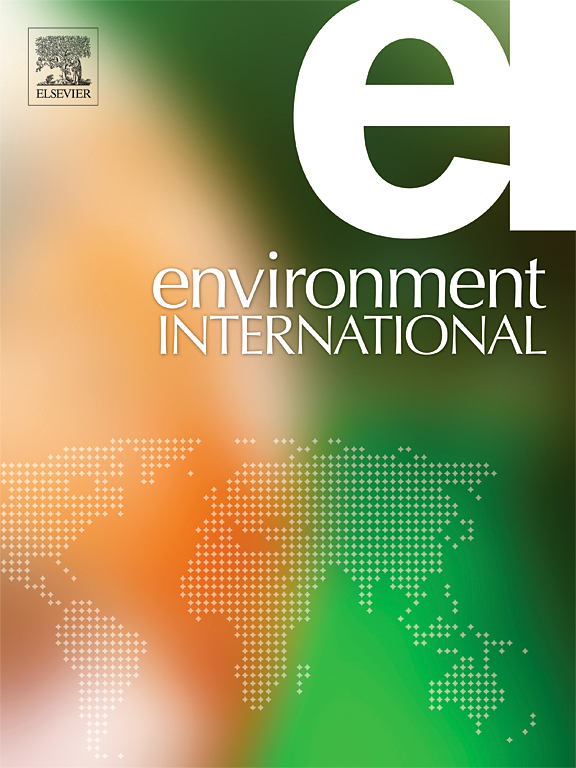Environmental contaminants, heavy metals, and essential elements in Norwegian children and adolescents: Data from the Norwegian environmental biobank
IF 10.3
1区 环境科学与生态学
Q1 ENVIRONMENTAL SCIENCES
引用次数: 0
Abstract
We are daily exposed to various environmental contaminants, including heavy metals, with suspected adverse health effects, and children’s vulnerability is particularly concerning. Human biomonitoring is crucial for measuring these contaminants and essential elements in the body. The Norwegian Environmental Biobank (NEB), coordinated by the Norwegian Institute of Public Health, has collected biological samples (including blood and urine) and questionnaire data systematically since 2016. Identifying population subgroups at elevated risk is essential for implementing protective measures. This study aimed to describe concentrations of environmental contaminants and essential elements in Norwegian children and explored potential clustering among different contaminants. Additionally, we examined differences across groups defined by family socio-demographic factors. A total of 81 environmental contaminants were measured in urine, plasma, and whole blood from children aged 7–14 years participating in NEB. Twenty-six non-persistent and 24 persistent contaminants were quantified in ≥ 50 % of the samples, along with nine essential elements. Most children had contaminant levels below Human Biomonitoring Guidance Values (HBM-GVs). However, nearly all children had bisphenol A levels exceeding the updated tolerable daily intake set by the European Food Safety Authority (EFSA), and 30 % had blood concentrations of the four most common per- and polyfluoroalkyl substances (PFAS) exceeding EFSA’s safe limits. Statistically significant differences in contaminant levels were observed between groups defined by sociodemographic variables such as sex, age, region, and degree of urbanization. Network analysis indicated clear clusters of several contaminants. This study shows that Norwegian children are exposed to a broad range of environmental contaminants, with levels similar to those reported in other studies from Europe and globally.
挪威儿童和青少年的环境污染物、重金属和必需元素:来自挪威环境生物银行的数据
我们每天都接触到各种环境污染物,包括重金属,这些污染物可能对健康产生不利影响,儿童的脆弱性尤其令人担忧。人体生物监测对于测量这些污染物和人体必需元素至关重要。挪威环境生物银行(NEB)由挪威公共卫生研究所协调,自2016年以来系统地收集了生物样本(包括血液和尿液)和问卷数据。确定高危人群亚群对于实施保护措施至关重要。本研究旨在描述挪威儿童的环境污染物和基本元素的浓度,并探索不同污染物之间的潜在聚类。此外,我们还检查了由家庭社会人口因素定义的群体之间的差异。在参与NEB的7-14岁 儿童的尿液、血浆和全血中,共测量了81种环境污染物。在 ≥ 50 %的样本中,对26种非持久性和24种持久性污染物以及9种必需元素进行了量化。大多数儿童的污染物水平低于人类生物监测指导值(HBM-GVs)。然而,几乎所有儿童的双酚A含量都超过了欧洲食品安全局(EFSA)设定的最新每日可耐受摄入量,30% %的儿童血液中四种最常见的全氟和多氟烷基物质(PFAS)的浓度超过了欧洲食品安全局的安全限值。根据性别、年龄、地区和城市化程度等社会人口变量定义的人群之间,污染物水平在统计上存在显著差异。网络分析显示了几种污染物的清晰集群。这项研究表明,挪威儿童暴露于各种各样的环境污染物中,其水平与欧洲和全球其他研究报告的水平相似。
本文章由计算机程序翻译,如有差异,请以英文原文为准。
求助全文
约1分钟内获得全文
求助全文
来源期刊

Environment International
环境科学-环境科学
CiteScore
21.90
自引率
3.40%
发文量
734
审稿时长
2.8 months
期刊介绍:
Environmental Health publishes manuscripts focusing on critical aspects of environmental and occupational medicine, including studies in toxicology and epidemiology, to illuminate the human health implications of exposure to environmental hazards. The journal adopts an open-access model and practices open peer review.
It caters to scientists and practitioners across all environmental science domains, directly or indirectly impacting human health and well-being. With a commitment to enhancing the prevention of environmentally-related health risks, Environmental Health serves as a public health journal for the community and scientists engaged in matters of public health significance concerning the environment.
 求助内容:
求助内容: 应助结果提醒方式:
应助结果提醒方式:


